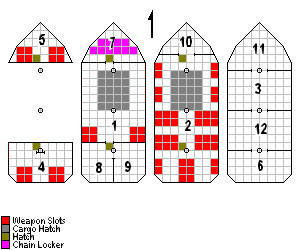The heavy galleon is the master vessel of the Gaelethian seas. Able to withstand the harsh ocean environment of a moon-world, as well as repel pirates and boarders, it serves as cargo vessel, warship, and transport for those nations that use them. The best heavy galleons in the world are made by only two nations -- the Holy City of Karmen, and the nation of Rakore. Few other nations can afford the construction materials cost and manpower to make these magnificent vessels -- especially with their conventional armorments. Their deep-sea capabilities and massive cargo stores make them the preferred ship for any man that can afford one.
Design A permenantly attached step-and-ladder hookup is usually attached to both sides of the vessel, even with the cargo-holds. Because of their draft, heavy galleons rarely can actually dock -- and must therefore use their longboats, or other vessels, to transport their cargo to and from land. 1. Main Deck: The main deck sports the massive cargo hatches, usually with two longboats stored and stowed atop them. Two light catapults abut the aft castle. The captain's cabin and the officers' cabin usually abut one another, but on some vessels, the captain's cabin can dominate the entire aft main deck. Massive cranes attached to the two primary masts can be used for simultaneous loading into the cargo holds. 2. Gun Deck: The gun deck provides the primary armorment for these massive vessels. Merchant versions use this as additional cargo space, but the military version sports two port and two starboard heavy ballistae, as well as a heavy ballista aft. The heavy ballistae are supported by six light ballistae (3 port, and 3 starboard). The forward hold provides arms lockers and ammunition, in addition to whatever ballistae bolts might be stored in overhead tubes. The cargo hatches go through this deck. Civilian versions usually use the foreward hold as a spare cabin. 3. Cargo Hold: The primary cargo hold can store massive objects, and usually has a reinforced decking (AC 5, Hardness 5, HP 35). 4. Quarter Deck: The aft castle (known as the quarter deck) usually sports two light catapults, as well as the main wheel. From here, the quartermaster controls the direction of the ship, while the officer-on-deck can consult charts and direct the crew. Small tables and benches usually litter this deck, when not dominated by the stowed light catapults. 5. Forecastle: The forward castle (or forecastle) usually sports two light catapults. The figurehead of the ship is usually mounted here, just under the bowspit. 6. Galley: Below-decks and aft serves as the primary provisions storage and galley for the massive vessel. The galley is where the cook works out of and serves the crew. 7. Chain Locker: Located on the main deck, beneath the forecastle, the chain locker holds the two massive chains for the port and starboard anchors. It also serves as the additional supplies locker, with extra sails and materiel. 8. Captain's Cabin: Here, the captain of the ship holds conferences with his officers, rests alone, and usually dines. Most of the vessels logs and navigational charts are usually stored here. 9. Officers' Quarters: Here, the other officers of the vessel usually stay in relative comfort, taking their meals separately from the crew. The officers' quarters can also serve as visiting dignitaries' quarters, and as an arms locker. 10. Forward Hold: Usually right on the waterline and fore, the forward hold contains additional provisions, supplies, and equipment. On military vessels, it can serve as an ammunition hold or smithy. 11. Bow Hold: Usually located below the waterline and fore, the bow hold sometimes serves as the marines' quarters, or additional cargo space for longer missions. 12. Middle Hold: On cargo vessels, the middle hold serves as addititional storage space. For military vessels, it serves as the crew's general quarters and general provisions area. |
 Main |
 Gaeleth |
 Jazed |
 Brijanis |
